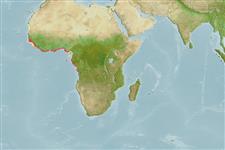Teleostei >
Clupeiformes (Herrings) >
Dorosomatidae (Gizzard shads and sardinellas)
Etymology: Ethmalosa: Greek, ethmos, -ou = sieve, also the ethmoides bone + Latin, alausa = a fish cited by Ausonius and Latin, halec = pickle, dealing with the Greek word hals = salt; it is also the old Saxon name for shad = "alli" ; 1591 (Ref. 45335).
Environment: milieu / climate zone / depth range / distribution range
生態學
海洋; 淡水; 半鹹淡水; 降海洄游 (Ref. 51243); 深度上下限 0 - ? m (Ref. 54436), usually 0 - 50 m (Ref. 54436). 熱帶; 25°N - 8°S, 17°W - 14°E (Ref. 54436)
Atlantic Ocean: Eastern central Atlantic Ocean, from Dakhla in Western Sahara southward to Lobito Bay in Angola (Ref. 188, 5286, 81269, 81631), occasionally entering freshwater (Ref. 3509). Reports from Cape Verde Islands are based on an erroneous type locality for Clupea fimbriata by Bowdich (1825), which was later rectified as probably Gambia (Ref. 188, 5286, 94080).
中東大西洋: 被對應到 25 °C 年度等溫線的最北與最南的極限的西撒哈拉的達赫拉到至少安哥拉的洛比托; 矮小的族群在貝南的瑙固維湖存在。 維德角記錄以錯誤的模式標本產地為依據為 Bowdich 的 篩鯡〔Ethmalosa fimbriata〕 - 跟隨著較後的命名者了。
Length at first maturity / 大小 / 重量 / 年齡
Maturity: Lm 17.0 range ? - 18.5 cm
Max length : 46.0 cm TL 雄魚/尚未辨別雌雄; (Ref. 1989); common length : 25.0 cm TL 雄魚/尚未辨別雌雄; (Ref. 187); 最大體重: 1.0 kg (Ref. 1989)
背棘 (總數): 0; 背的軟條 (總數): 16-19; 臀棘 0; 臀鰭軟條: 19 - 25; 脊椎骨: 40 - 44. Diagnosis: Body fairly deep, compressed, scutes present along belly; upper jaw with distinct notch, into which tip of lower jaw fits; lower gillrakers long, fine and numerous, about 3 times as long as gill filaments, upper gillrakers bent sharply upward, V-shaped; pelvic fin rays with 1 unbranched and 7 branched rays; caudal fin tips long and pointed (Ref. 188). A faint dark spot behind gill cover, sometimes followed by others; dorsal fin tip black; caudal fin deep chrome yellow; golden tints on body (Ref. 188, 81269). Ethmalosa fimbriata resembles Sardinella aurita, Sardinella rouxi and especially Sardinella maderensis, but these are more slender, have a rounded upper jaw which is not notched and the upper gillrakers are not bent upward like an elbow (Ref. 188).
上頜有明顯的中央凹槽, 進入那一個之內下頜的頂端適合。 下鰓耙長的﹐細且多, 大約 3 倍長於鰓絲; 上面的鰓耙彎曲銳利向上, V 形的。 尾鰭深的鉻, 頂端長而尖的。 一個模糊的深色斑點在後鰓蓋;(有時跟隨著其它) 背鰭頂端黑色; 在身體上的金色光澤。 鱗甲: 16-19 腹鰭前的,10-13 後。 在側線列 37-42 中的鱗片.
Ethmalosa fimbriata is found in fairly shallow coastal waters, lagoons and estuaries, and sometimes also in lower courses of coastal rivers, even more than 300 km up rivers (Ref. 187, 188, 81269, 81631). It feeds principally on phytoplankton, chiefly diatoms, filtered by the very fine gillraker sieve (Ref. 187, 188, 3166). It breeds throughout the year in waters of salinities 3.5-38 ppt, but with peaks in at least some areas; spawns in the sea, in estuaries and in rivers (Ref. 188). The largest fisheries are in Senegal, Sierra Leone, Ivory Coast, Nigeria and Cameroon, mainly in the dry season (Ref. 188).
出現於近岸水域,潟湖與超過 300 公里從河口向上 (例如甘比亞河). 濾食浮游植物, 主要地矽藻。 全年繁殖在鹽度 3.5-38 ppt 的水域中, 在至少一些區域中但是有峰巔。 產卵在海中, 在河口與河中。 吃浮游植物, 主要地矽藻。 在市場上銷售生鮮地了, 也煙燻了而且乾製了。
Life cycle and mating behavior
成熟度 | 繁殖 | 產卵場 | 卵 | 孕卵數 | 仔魚
Breeds all year in waters of salinities 3.5 to 38 ppt, but with peaks in at least some areas, becoming progressively later to south. Spawns in the sea, in estuaries and in rivers.中東大西洋: 被對應到 25 °C 年度等溫線的最北與最南的極限的西撒哈拉的達赫拉到至少安哥拉的洛比托; 矮小的族群在貝南的瑙固維湖存在。 維德角記錄以錯誤的模式標本產地為依據為 Bowdich 的 篩鯡〔Ethmalosa fimbriata〕 - 跟隨著較後的命名者了。
Whitehead, P.J.P., 1985. FAO Species Catalogue. Vol. 7. Clupeoid fishes of the world (suborder Clupeoidei). An annotated and illustrated catalogue of the herrings, sardines, pilchards, sprats, shads, anchovies and wolf-herrings. FAO Fish. Synop. 125(7/1):1-303. Rome: FAO. (Ref. 188)
人類使用
漁業: 高經濟性; 養殖: 實驗的
更多資訊
合作者照片Stamps, Coins Misc.聲音神經毒速度泳型鰓區Otoliths腦重體重比眼睛色素
工具
特別的報告
下載 XML
網路資源
Estimates based on models
Preferred temperature (Ref.
123201): 20.2 - 27.9, mean 26.4 °C (based on 180 cells).
Phylogenetic diversity index (Ref.
82804): PD
50 = 1.0000 [Uniqueness, from 0.5 = low to 2.0 = high].
Bayesian length-weight: a=0.00933 (0.00806 - 0.01080), b=3.05 (3.01 - 3.09), in cm total length, based on LWR estimates for this species (Ref.
93245).
營養階層 (Ref.
69278): 2.5 ±0.20 se; based on food items.
回復力 (Ref.
120179): 高度, 族群倍增時間少於 15個月 (K=0.25-0.36; tm=1; Fec=16,000).
Prior r = 0.93, 95% CL = 0.61 - 1.39, Based on 5 stock assessments.
Fishing Vulnerability (Ref.
59153): Low vulnerability (21 of 100).
Climate Vulnerability (Ref.
125649): High vulnerability (60 of 100).
Nutrients (Ref.
124155): Calcium = 181 [96, 321] mg/100g; Iron = 1.91 [1.04, 3.19] mg/100g; Protein = 19 [17, 21] %; Omega3 = 0.374 [0.211, 0.670] g/100g; Selenium = 65.7 [32.1, 137.4] μg/100g; VitaminA = 8.42 [3.24, 21.22] μg/100g; Zinc = 1.75 [1.23, 2.59] mg/100g (wet weight); based on
nutrient studies.
